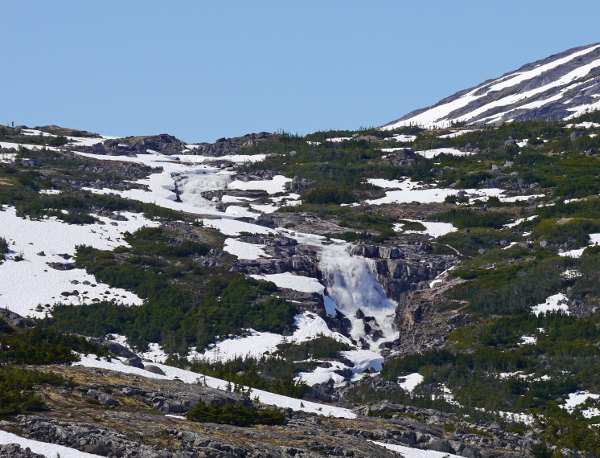What is Snowmelt?
What is Snowmelt?
As air temperatures rise in the spring, snowpack begins to melt. The water that becomes runoff into streams or recharge into soil is called snowmelt (Figure 1). Most of the snowmelt is a source of water for groundwater recharge. Snowmelt contributes substantial water to soil moisture. Part of the snowmelt that infiltrates into the soil contributes to shallow and deep groundwater. In the late spring the water levels in the river are high because of heavy rainfall experienced at this time. Once rainfall becomes less frequent in the fall, the snowmelt that was stored in the ground will return to the surface and make up the baseflow of the river. In mountains, snowmelt primarily occurs from May to July. Snowmelt occurs earlier in the prairie regions (March to April) [1].
 |
| Figure 1. Snowmelt. When snowpack melts in the spring, some of the snowmelt enters streams, increasing the amount of water in the stream [2]. |
Does snowmelt cause flooding?
| Fast Fact: Sunlight, or solar radiation, is the main driver of snowmelt. Air temperature and solar radiation are correlated. In the spring there is more sunlight. This increase in solar radiation causes temperatures to rise and snow to melt. |
Sometimes snowmelt can cause flooding. When air temperatures stay below freezing in the spring, a large amount of snowpack can remain intact well into the late spring. Once the snowpack has accumulated enough energy, melting can occur rapidly. This is known as freshet flooding. Generally, snow melts rapidly in the prairies, so freshet flooding is minor and occurs on small streams. In the mountains, snowmelt is very gradual; it takes several months for the snow to melt. Due to the slow rate of melting, mountain snowmelt usually is not a primary cause of flooding [3].
What was the role of snowmelt in the Great Alberta Flood of 2013?
In Alberta, rain is the biggest factor that contributes to flooding although snowpack and snowmelt can also have a role to play.
Sometimes rainstorms, which are common in the late spring, fall on the snowpack and create more rapid snowmelt. In extreme circumstances, this can create a large flood. In 2012, there was a record amount of snowpack in Alberta, but no severe flooding. In 2013 the amount of snowpack was average, but a heavy rain event in late May caused the snow to begin melting rapidly [4]. Snowmelt was a relatively small factor in the magnitude of the 2013 flood. The biggest contributor was the large amount of warm rain that fell across the province on June 19th, 2013. For example, a rain gauging station west of High River recorded 325mm of rain in 48 hours [5].
Sources:
[1]Alberta Environment and Sustainable Resource Development (2015). Frequently Asked Questions – Advisories and Warnings. Retrieved from: http://www.environment.alberta.ca/forecasting/FAQ/advisories.html
[2] “snowmelt” by Kristi is licenced under CC BY 2.0.
[3] Alberta Environment and Sustainable Resource Development (2014). Does snowpack predict flooding? The answer might surprise you. Retrieved from: https://aesrd.wordpress.com/2014/04/28/does-snowpack-predict-flooding-the-answer-might-surprise-you/
[4] Environment Canada (2014). Alberta’s Flood of Floods. Retrieved from: http://www.ec.gc.ca/meteo-weather/default.asp?lang=En&n=5BA5EAFC-1&offset=2&toc=show
[5] Graveland, Bill (2014). Alberta Snowpack Only Slightly Above Normal. The Canadian Press. Retrieved from: http://globalnews.ca/news/1229679/alberta-snowpack-only-slightly-above-normal/
